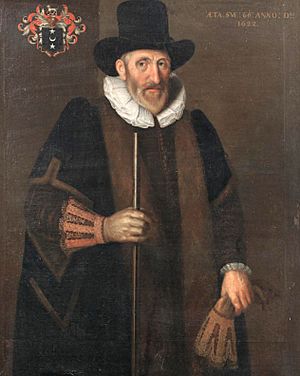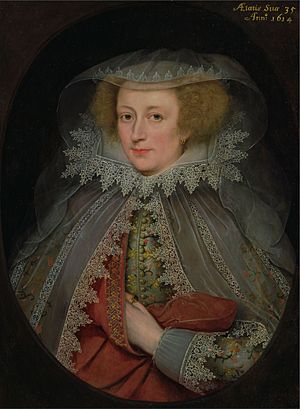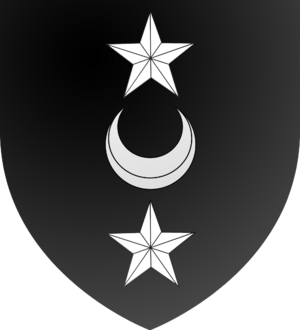Thomas Jermyn (1573–1645) facts for kids
Quick facts for kids
Sir Thomas Jermyn
|
|
|---|---|

A portrait of Thomas Jermyn in circa 1622
|
|
| Comptroller of the Household | |
| In office 1639–1641 |
|
| Monarch | Charles I |
| Preceded by | Henry Vane the Elder |
| Succeeded by | Sir Peter Wyche |
| Personal details | |
| Born | 1573 |
| Died | 1645 |
| Parents | Sir Robert Jermyn Judith Blagge |
Sir Thomas Jermyn (1573–1645) was an important English soldier and politician from Rushbrooke, Suffolk. He was a Royalist (meaning he supported the King) during the English Civil War. He served as a Member of Parliament (a person elected to help make laws) for many years, from 1604 to 1640. He also became a powerful courtier, which means he was an important person at the King's court. From 1639 to 1641, he was the Comptroller of the Household for King Charles I.
Early Life and Military Career
Thomas Jermyn was born in 1573. His father was Sir Robert Jermyn, and his mother was Judith Blagge. He went to Emmanuel College, Cambridge in 1585 and later studied law at the Middle Temple in 1590.
From 1591 to 1592, he joined the army as a volunteer during the French Wars of Religion. He fought alongside King Henry IV in the Siege of Rouen, which was an attempt to capture the city. He was made a knight by the Earl of Essex in 1591.
Jermyn continued to fight under the Earl of Essex in the war against Spain. He was part of the Capture of Cádiz in 1596, where English forces captured the Spanish city. In 1597, he took part in a naval expedition called the Islands Voyage.
He then served in the Nine Years' War in Ireland. In 1599, he gathered a group of soldiers in Suffolk and became their colonel, leading them to fight in Connaught. Even though he was connected to the Earl of Essex, he managed to avoid getting involved in Essex's Rebellion in 1601. In 1603, he became a Knight of the Bath and was appointed a gentleman of the privy chamber when James I became king.
Political and Court Career
In 1604, Sir Thomas Jermyn was elected as a Member of Parliament for Andover. He worked on a committee that looked into uniting England and Scotland. In 1607, he helped the Virginia Company, which was a group that set up colonies in America. He remained an MP for Andover until 1611.
In 1614, he was elected to represent Suffolk, a more important position. That same year, he inherited his father's lands. In 1615, he became a deputy lieutenant for Suffolk, helping to manage local military forces. He also traveled to France in 1616 with a diplomatic group led by Lord Hay. In 1617, he was appointed a justice of the peace for Suffolk, which meant he helped keep law and order.
Jermyn was elected as an MP for Bury St Edmunds several times between 1621 and 1628. In 1623, he went with the Prince of Wales (who later became King Charles I) and the Duke of Buckingham to Spain. They hoped to arrange a marriage between the prince and a Spanish princess.
By 1624, Jermyn openly criticized Spain's policies. He argued in the House of Commons that England should immediately end its relationship with Spain. In 1626, he was on a parliamentary committee that discussed a plan for a private war against Spain. He also defended the Duke of Buckingham when Parliament tried to remove him from office. There were rumors in 1626–1627 that Jermyn might become a peer (a high-ranking noble), but this never happened.
In the 1628 Parliament, Jermyn generally supported the King's plans and his efforts to raise more taxes. However, he also supported the Petition of Right, a document passed in 1628 that limited the King's power. He also spoke against John Eliot for criticizing the King's ministers. In 1629, King Charles I decided to rule without Parliament for eleven years, and the House of Commons was dismissed.
By 1629, Jermyn was having money problems and looked for a higher position at court. In 1630, he became vice-chamberlain of the royal household and a member of the Privy Council of England, a group of advisors to the King. In 1631, he became the Governor of Jersey, though he didn't live there. Throughout the 1630s, he served on several government committees. In 1639, Jermyn was appointed Comptroller of the Royal Household, a very important role in the King's court.
In April 1640, Jermyn was re-elected for Bury St Edmunds in the Short Parliament. A few months later, he was elected to the Long Parliament. He also became Lord Lieutenant of Suffolk that same year.
In 1641, he sold his court position for £2,000 and planned to retire. However, he was called back to Parliament in 1642 because he was suspected of sending money to the King to raise an army. During the English Civil War, he fought as a Royalist, supporting the King. He was injured in 1644 and died the next year at age 72. He was buried at Rushbrooke in January 1645. He left his property to his second wife. His son Thomas inherited his estate and debts.
Family Life

On November 26, 1599, Sir Thomas Jermyn married Catherine Killigrew (1579–1640). Catherine was the daughter of Sir William Killigrew, who worked for Queen Elizabeth I and King James I.
Thomas and Catherine had four sons and one daughter. Sadly, in 1605, their daughter Elizabeth died after accidentally eating rat poison. Their children who lived to adulthood were:
- Robert Jermyn (1601–1623), who was also an MP, but he died before his father.
- Thomas Jermyn (1604–1659), who was their oldest son to survive. He also became an MP for Bury St Edmunds.
- Henry Jermyn (1605–1684), who later became the 1st Earl of St Albans. He was also an MP, a courtier, and a Royalist.
On March 17, 1642, Sir Thomas Jermyn married his second wife, Mary (died 1679). She was the daughter of Edmund Barber and the widow of Thomas Newton. They had one daughter named Elizabeth, who married Cyril Wyche.
|


